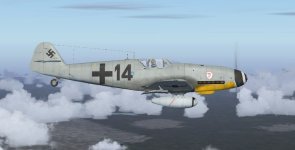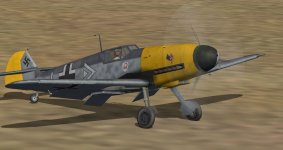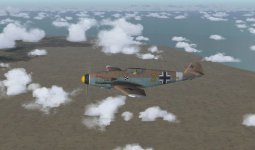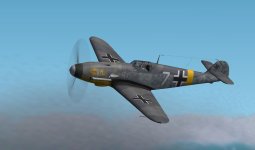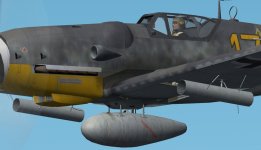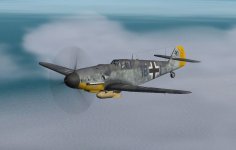Team Daedalus
Members +
Messerschmitt Bf109G-6/AS
by Design Team Daedalus
Unit: 2./JG3 Burg bei Brandenburg, May 1944
Pilot: Usually flown by Fw. Horst Petzschler, but was shot down on May 30 being flown by Fw. Otto Büsser (KIA)
I./JG3 and II./JG3 were routinely assigned to fly top cover hence the light blue RLM 76 overall camouflage thought appropriate for such high altitude missions.
The basic Bf109G-6 model that was produced through early 1944 used the Daimler Benz DB605A engine. In late 1943 work began on improving the high altitude performance through the installation of a more effective supercharger. Production of the new engine designated DB605AS (Sonder) started in early 1944. The new supercharger had a higher output allowing the engine to produce horsepower longer at higher altitudes. (As altitude increases, the horsepower an engine can produce decreases)
To accommodate the new engine supercharger shape, the 109 nose cowling had to be redesigned. As part of the redesign, the MG131 bulge covers were replaced by a streamlined engine cover. The supercharger inlet was also enlarged. The methanol/wasser MW50 injection system was usually fitted which provided increased boost pressure and about 130 hp increase at low altitudes for short periods of time.
As the improved DB605AS engine was intended to give the Bf109 a better high altitude performance, it was also necessary to increase the tailplane/rudder area by extending the height to allow better maneuverability in the thin air at high altitude.
The first G-6/AS aircraft reached frontline units in early April, 1944 - III/JG, I/JG5 and II/JG11. I/JG3 received them in May and II/JG/27 got theirs in June, along with a few going to NJGr.10.
There is no "standard" Bf 109G-6/AS, as the production included conversions of basic G-6 models and different radio equipment, oil cooler types, antenna masts, etc. were available at different times during the production runs. So each model we have created has its own unique features.
Pstrany developed the models using Paul Rebuffat's Messerschmitt model - with permission - as a starting framework and updated the shape, and added a plethora of details, new parts, and ideas. Pstrany also developed the models for the drop tanks, weapons and racks.
Captain Kurt created paints for each, the 2D instrument panel, the air files and the aircraft.cfg files.
Mav SCASM edited each model so that they have animated wing slats, drop tanks, and other features, as well as optimizing models for the best possible frame rates.
We have all benefited from the assistance and guidance of others in the community. Special thanks to Wolfi and Huub Vink for their kind assistance and to all who have contributed their knowledge directly and indirectly.

by Design Team Daedalus
Unit: 2./JG3 Burg bei Brandenburg, May 1944
Pilot: Usually flown by Fw. Horst Petzschler, but was shot down on May 30 being flown by Fw. Otto Büsser (KIA)
I./JG3 and II./JG3 were routinely assigned to fly top cover hence the light blue RLM 76 overall camouflage thought appropriate for such high altitude missions.
The basic Bf109G-6 model that was produced through early 1944 used the Daimler Benz DB605A engine. In late 1943 work began on improving the high altitude performance through the installation of a more effective supercharger. Production of the new engine designated DB605AS (Sonder) started in early 1944. The new supercharger had a higher output allowing the engine to produce horsepower longer at higher altitudes. (As altitude increases, the horsepower an engine can produce decreases)
To accommodate the new engine supercharger shape, the 109 nose cowling had to be redesigned. As part of the redesign, the MG131 bulge covers were replaced by a streamlined engine cover. The supercharger inlet was also enlarged. The methanol/wasser MW50 injection system was usually fitted which provided increased boost pressure and about 130 hp increase at low altitudes for short periods of time.
As the improved DB605AS engine was intended to give the Bf109 a better high altitude performance, it was also necessary to increase the tailplane/rudder area by extending the height to allow better maneuverability in the thin air at high altitude.
The first G-6/AS aircraft reached frontline units in early April, 1944 - III/JG, I/JG5 and II/JG11. I/JG3 received them in May and II/JG/27 got theirs in June, along with a few going to NJGr.10.
There is no "standard" Bf 109G-6/AS, as the production included conversions of basic G-6 models and different radio equipment, oil cooler types, antenna masts, etc. were available at different times during the production runs. So each model we have created has its own unique features.
Pstrany developed the models using Paul Rebuffat's Messerschmitt model - with permission - as a starting framework and updated the shape, and added a plethora of details, new parts, and ideas. Pstrany also developed the models for the drop tanks, weapons and racks.
Captain Kurt created paints for each, the 2D instrument panel, the air files and the aircraft.cfg files.
Mav SCASM edited each model so that they have animated wing slats, drop tanks, and other features, as well as optimizing models for the best possible frame rates.
We have all benefited from the assistance and guidance of others in the community. Special thanks to Wolfi and Huub Vink for their kind assistance and to all who have contributed their knowledge directly and indirectly.

